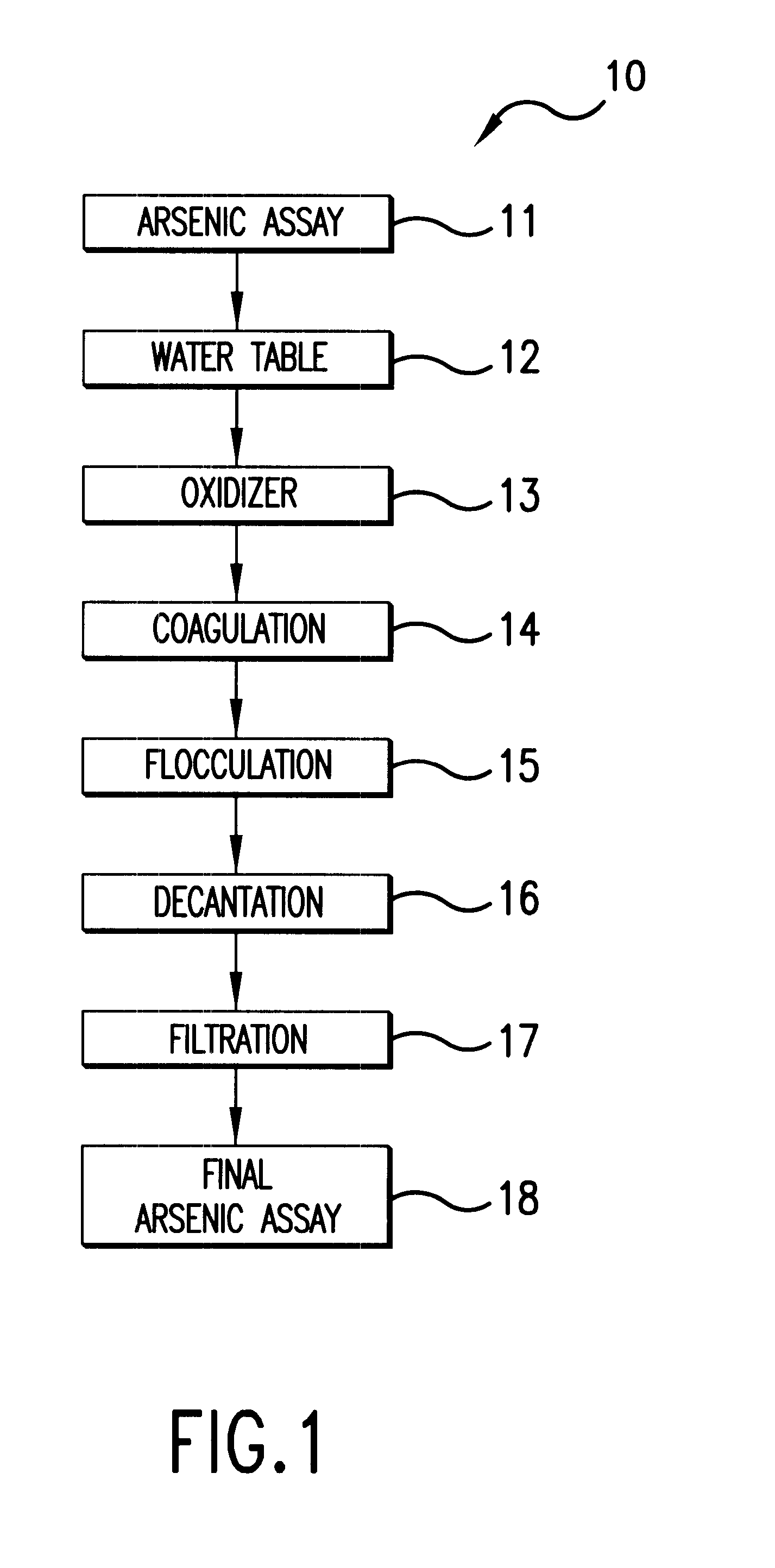Composition for arsenic removal from ground water
a technology of arsenic removal and composition, which is applied in the direction of water softening, other chemical processes, separation processes, etc., can solve the problems of arsenic ingestion by people in less developed countries, and achieve the effect of simple process and composition
- Summary
- Abstract
- Description
- Claims
- Application Information
AI Technical Summary
Benefits of technology
Problems solved by technology
Method used
Image
Examples
example 1
This example relates to adding clay alone (activated bentonite) to arsenic-containing water and measuring the amount of arsenic removal from the water. Six 1,000 ml glasses were filled with equal quantities of water and placed in a jar test device. The test device includes a motorized helical agitator. The helical agitator is first set at a rotation speed of 100 rpm. Clay is weighed and added to the water. The clay was mixed with the water by maintaining the rotation speed of the agitator at 100 rpm for one minute. The rotation speed of the agitator was then reduced to 40 rpm. The agitation at 40 rpm was maintained for 20 minutes, then the mixture was allowed to settle for 20 minutes. Upon settling of the mixture, the liquid was filtered to separate the precipitate formed at the bottom of the device. Aliquot samples were taken and arsenic assays conducted to determine the arsenic content of the treated water (Water Arsenic Content).
Table 1 shows the results for six experiments corre...
example 2
This example relates to adding a coagulant alone (aluminum sulfate or ferric chloride) to arsenic-containing water and measuring arsenic removal from the water. For each coagulant, six experiments are conducted by filling 1,000 ml glasses with equal quantities of water. The tests are conducted in according to the protocol described in Example 1.
The results obtained with aluminum sulfate alone are presented in Table 2A. and those obtained with ferric chloride alone are presented in Table 2B. The results show that treating the water with a coagulant alone removes less than 20 wt % of the arsenic initially present in the water.
TABLE 2B
example 3
This example relates to adding both a clay (activated bentonite) and a coagulant (aluminum sulfate or ferric chloride) to arsenic-containing water and measuring arsenic removal from the water. The clay and coagulant are added in various weight ratios. The experiments are conducted according to a protocol similar to the protocol used in Examples 1 and 2. The results are presented in Tables 3A to 3F.
Treating the water with both a clay and a coagulant provides an arsenic removal percentage higher than the added arsenic removal percentages associated with using the clay and the coagulant separately. In particular, the results show a 79 wt % arsenic removal when the water is treated with a combination of clay and ferric chloride with a weight ratio of 1000 / 50, compared to only 11.5 (4.5+7) wt % arsenic removal corresponding to the added effects of the clay and the coagulant, when used separately.
TABLE 3B
TABLE 3C
TABLE 3D
TABLE 3E
TABLE 3F
PUM
| Property | Measurement | Unit |
|---|---|---|
| Temperature | aaaaa | aaaaa |
| Fraction | aaaaa | aaaaa |
| Fraction | aaaaa | aaaaa |
Abstract
Description
Claims
Application Information
 Login to View More
Login to View More - R&D
- Intellectual Property
- Life Sciences
- Materials
- Tech Scout
- Unparalleled Data Quality
- Higher Quality Content
- 60% Fewer Hallucinations
Browse by: Latest US Patents, China's latest patents, Technical Efficacy Thesaurus, Application Domain, Technology Topic, Popular Technical Reports.
© 2025 PatSnap. All rights reserved.Legal|Privacy policy|Modern Slavery Act Transparency Statement|Sitemap|About US| Contact US: help@patsnap.com



